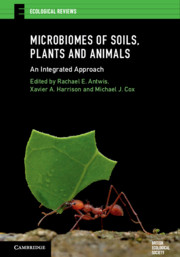Book contents
- Microbiomes of Soils, Plants and Animals
- Ecological Reviews
- Microbiomes of Soils, Plants and Animals
- Copyright page
- Contents
- Contributors
- Preface
- Abbreviations
- Chapter One Microbiomes of soils, plants and animals: an introduction
- Chapter Two Analytical approaches for microbiome research
- Chapter Three Microbiomes of soils
- Chapter Four Factors that shape the host microbiome
- Chapter Five Microbial symbioses and host nutrition
- Chapter Six The microbiome and host behaviour
- Chapter Seven Host microbiomes and disease
- Chapter Eight Adapting to environmental change
- Chapter Nine Microbial biotechnology
- Chapter Ten Synthesis and future directions
- Index
- Plate Section (PDF Only)
- References
Chapter Ten - Synthesis and future directions
Published online by Cambridge University Press: 07 March 2020
- Microbiomes of Soils, Plants and Animals
- Ecological Reviews
- Microbiomes of Soils, Plants and Animals
- Copyright page
- Contents
- Contributors
- Preface
- Abbreviations
- Chapter One Microbiomes of soils, plants and animals: an introduction
- Chapter Two Analytical approaches for microbiome research
- Chapter Three Microbiomes of soils
- Chapter Four Factors that shape the host microbiome
- Chapter Five Microbial symbioses and host nutrition
- Chapter Six The microbiome and host behaviour
- Chapter Seven Host microbiomes and disease
- Chapter Eight Adapting to environmental change
- Chapter Nine Microbial biotechnology
- Chapter Ten Synthesis and future directions
- Index
- Plate Section (PDF Only)
- References
Summary
Our knowledge and understanding of the structure and function of complex host-associated communities has grown exponentially in the last decade through improvements in sequencing technologies. Despite this, there are still many outstanding research questions, which will undoubtably lead to many more. Concerted effort is required to elucidate the composition and function of taxonomic groups other than bacteria that constitute host microbiomes, and to extend our current cataloguing efforts to non-model and field-based host organisms. Further to this, we need to continue to move beyond the 'who?' question provided by relatively cheap amplicon sequencing to gain a better understanding of 'what?' the microbiome is doing, using metatranscriptomics approaches. Critically, we need to understand how members of the microbiome interact to confer function. Given the current unprecedented environmental change, microbiome plasticity may prove vital to host resilience and fitness. Furthermore, there is considerable potential for microbial biotechnology to improve numerous aspects of humanity, although care must be taken to ensure environmental and social justice prevail.
- Type
- Chapter
- Information
- Microbiomes of Soils, Plants and AnimalsAn Integrated Approach, pp. 222 - 226Publisher: Cambridge University PressPrint publication year: 2020

